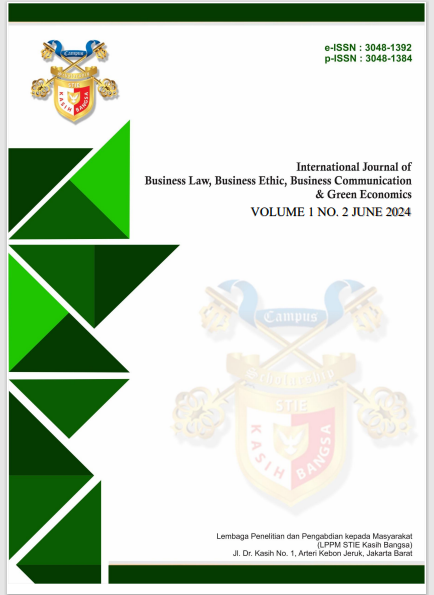The Balancing Act of Legal Investor Protection: A Literature Review on the Dual Role of Minority Shareholder and Creditor Safeguards in Corporate Investment Decisions
Keywords:
Investor protection, minority shareholders, creditor rights, firm investment decisions, regulatory trade-offAbstract
This qualitative literature review examines the regulatory trade-off in legal investor protection, focusing on the dual role of minority shareholder and creditor protection in influencing firm investment decisions. The findings reveal that robust minority shareholder protection enhances equity market confidence and encourages long-term investments, while strong creditor rights reduce default risks but may limit managerial flexibility and risk-taking. The study highlights the contextual dynamics of these trade-offs across legal systems and market maturities, with developed markets benefiting from complementary protections and emerging markets facing prioritization challenges. This review underscores the importance of balanced legal frameworks tailored to specific economic and institutional contexts. Limitations include geographic bias, reliance on secondary data, and limited stakeholder focus. Future research should explore cross-country analyses and the role of technological advancements in corporate governance.
References
Acharya, V. V., Amihud, Y., & Litov, L. (2011). Creditor rights and corporate risk-taking. Journal of Financial Economics, 102(1), 150–166.
https://doi.org/10.1016/j.jfineco.2011.04.001
Acharya, V. V., Sundaram, R. K., & John, K. (2011). Cross-country variations in capital structures: The role of bankruptcy codes. Journal of Financial Intermediation, 20(1), 25–54. https://doi.org/10.1016/j.jfi.2010.02.001
Aguilera, R. V., Desender, K., Bednar, M. K., & Lee, J. H. (2015). Connecting the dots: Bringing external corporate governance into the corporate governance puzzle. Academy of Management Annals, 9(1), 483–513. https://doi.org/10.1080/19416520.2015.1024503
Ahmadjian, C. L. (2016). Comparative institutional analysis and institutional complexity. Journal of Management Studies, 53(1), 12–27. https://doi.org/10.1111/joms.12178
Aghion, P., Bolton, P., & Fries, S. (1999). Optimal design of bank bailouts: The case of transition economies. Journal of Institutional and Theoretical Economics, 155(1), 51–70.
Almeida, H., & Campello, M. (2007). Financial constraints, asset tangibility, and corporate investment. Review of Financial Studies, 20(5), 1429–1460. https://doi.org/10.1093/rfs/hhm019
Andrén, N., & Jankensgård, H. (2020). Disappearing investment-cash flow sensitivities: Earnings have not become a worse proxy for cash flow. Journal of Business Finance & Accounting, 47(5–6), 760–785.
Armour, J., & Deakin, S. (2019). Legal origin and investor protection: The evolving role of shareholder and creditor rights. Journal of Corporate Law Studies, 19(1), 121–143.
Armour, J., Deakin, S., Mollica, V., & Siems, M. (2009). Law and financial development: What we are learning from time-series evidence. European Corporate Governance Institute (ECGI) - Law Working Paper No. 151/2010. https://doi.org/10.2139/ssrn.1539803
Beck, T., Demirgüç-Kunt, A., & Levine, R. (2003). Law and finance: Why does legal origin matter? Journal of Comparative Economics, 31(4), 653–675.
Becker, B., & Sivadasan, J. (2010). The effect of financial development on the investment-cash flow relationship: Cross-country evidence from Europe. B.E. Journal of Economic Analysis & Policy, 10(1), 1–49. https://doi.org/10.2202/1935-1682.2302
Benardi Benardi, Ngadi Permana, & Mohammad Chaidir. (2024). Dampak Keterlibatan Institusi Keuangan terhadap Sophistication Finansial dan Pengeluaran Konsumen . Jurnal Visi Manajemen, 10(2), 123–133. https://doi.org/10.56910/jvm.v10i2.555
Bowles, S. (2004). Microeconomics: Behavior, institutions, and evolution. Princeton University Press.
Burkart, M., Gromb, D., & Panunzi, F. (2003). Minority shareholder protections and the private benefits of control. Journal of Financial Economics, 69(1), 263–289.
Claessens, S., & Yurtoglu, B. (2013). Corporate governance and development: An update. Focus 10, The International Finance Corporation.
Deakin, S., Mollica, V., & Sarkar, P. (2017). Varieties of creditor protection: Insolvency law reform and credit expansion in developed market economies. Socio-Economic Review, 15(2), 359–384. https://doi.org/10.1093/ser/mww005
Djankov, S., Hart, O., McLiesh, C., & Shleifer, A. (2008). Debt enforcement around the world. Journal of Political Economy, 116(6), 1105–1149.
https://doi.org/10.1086/595015
Djankov, S., McLiesh, C., & Shleifer, A. (2007). Private credit in 129 countries. Journal of Financial Economics, 84(2), 299–329. https://doi.org/10.1016/j.jfineco.2006.03.004
Francis, B., Hasan, I., Song, L., & Waisman, M. (2013). Corporate governance and investment–cash flow sensitivity: Evidence from emerging markets. Emerging Markets Review, 15, 57–71. https://doi.org/10.1016/j.ememar.2012.08.002
Jensen, M. C., & Meckling, W. H. (1976). Theory of the firm: Managerial behavior, agency costs, and ownership structure. Journal of Financial Economics, 3(4), 305–360.
Kabbach-de-Castro, L. R., Martins, H. C., Schiehll, E., & Terra, P. R. S. (2023). Investment–cash flow sensitivity and investor protection. Journal of Business Finance and Accounting, 50(7–8), 1402–1438. https://doi.org/10.1111/jbfa.12645
Kusnanto, E. (2022). Performance Measurement Based on Balance Scorecard Perspective of Sustainable Leadership, Corporate Governance and Human Capital in Banking Industry. International Journal of Contemporary Accounting, 4(1), 41–58. https://doi.org/10.25105/ijca.v4i1.13916
Kusnanto, E., Permana, N., Yulianti, G., 2022. Pengaruh Intellectual Capital, Institusional Ownership, dan Profitabilitas terhadap Financial Awareness dengan Cash Flow Volatility sebagai Variabel Intervening. Jurnal Ilmiah Akuntansi dan Humanika Vol. 12 No. 1 (2022) DOI: https://doi.org/10.23887/jiah.v12i1.40493
La Porta, R., Lopez-de-Silanes, F., Shleifer, A., & Vishny, R. W. (1997). Legal determinants of external finance. Journal of Finance, 52(3), 1131–1150.
La Porta, R., Lopez-de-Silanes, F., Shleifer, A., & Vishny, R. W. (1998). Law and finance. Journal of Political Economy, 106(6), 1113–1155.
https://doi.org/10.1086/250042
La Porta, R., Lopez-de-Silanes, F., Shleifer, A., & Vishny, R. W. (2000). Investor protection and corporate governance. Journal of Financial Economics, 58(1–2), 3–27. https://doi.org/10.1016/S0304-405X(00)00065-9
Lins, K. V., Volpin, P., & Wagner, H. F. (2013). Does family control matter? International evidence from the 2008–2009 financial crisis. Review of Financial Studies, 26(10), 2583–2619. https://doi.org/10.1093/rfs/hht044
Martins, H. C., Schiehll, E., & Terra, P. R. S. (2019). Do shareholder protection and creditor rights have distinct effects on the association between debt maturity and ownership structure? Journal of Business Finance and Accounting, 50(7–8), 1369–1402. https://doi.org/10.1111/jbfa.12430
Meyer, B., & Strömberg, P. (2021). The corporate governance effects of bankruptcy laws. Review of Financial Studies, 34(3), 1213–1251.
https://doi.org/10.1093/rfs/hhaa080
McLean, R. D., Zhang, T., & Zhao, M. (2012). Why does the law matter? Investor protection and its effects on investment, finance, and growth. Journal of Finance, 67(1), 313–350. https://doi.org/10.1111/j.1540-6261.2011.01713.x
Mohamad Chaidir, Grace Yulianti, & Benardi Benardi. (2024). Pengaruh Volatilitas Ekuitas dan Leverage terhadap Risiko Investasi . Jurnal Visi Manajemen, 10(1), 42–53. https://doi.org/10.56910/jvm.v10i1.556
Morck, R., Shleifer, A., & Vishny, R. W. (1988). Management ownership and market valuation: An empirical analysis. Journal of Financial Economics, 20(1–2), 293–315. https://doi.org/10.1016/0304-405X(88)90048-7
Page, M. J., McKenzie, J. E., Bossuyt, P. M., Boutron, I., Hoffmann, T. C., Mulrow, C. D., ... & Moher, D. (2021). The PRISMA 2020 statement: An updated guideline for reporting systematic reviews. BMJ, 372, n71. https://doi.org/10.1136/bmj.n71
Pagano, M., & Volpin, P. (2005). The political economy of corporate governance. American Economic Review, 95(4), 1005–1030.
Qian, J., & Strahan, P. E. (2007). How laws and institutions shape financial contracts: The case of bank loans. Journal of Finance, 62(6), 2803–2834.
Shleifer, A., & Vishny, R. W. (1997). A survey of corporate governance. Journal of Finance, 52(2), 737–783. https://doi.org/10.1111/j.1540-6261.1997.tb04820.x
Snyder, H. (2019). Literature review as a research methodology: An overview and guidelines. Journal of Business Research, 104, 333–339.
https://doi.org/10.1016/j.jbusres.2019.07.039
Sugiharti, T. (2023). Sustainable leadership best practices in enhancing business resilience and performance of robusta coffee farmers. Journal of Enterprise and Development (JED), 5(Special-Issue-2), 387–401.
https://doi.org/10.20414/jed.v5iSpecial-Issue-2.8051
Tanti Sugiharti. (2022). Optimalisasi Siklus Manajemen Kinerja untuk Pengembangan Kepemimpinan di Organisasi. Journal of Business, Finance, and Economics (JBFE), 3(1), 150–160. https://doi.org/10.32585/jbfe.v3i1.5717
Thomas, J., & Harden, A. (2008). Methods for the thematic synthesis of qualitative research in systematic reviews. BMC Medical Research Methodology, 8(1), 45. https://doi.org/10.1186/1471-2288-8-45
Williamson, O. E. (1981). The economics of organization: The transaction cost approach. American Journal of Sociology, 87(3), 548–577. https://doi.org/10.1086/227496
















